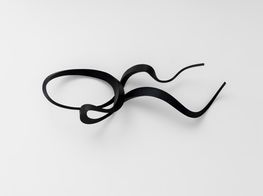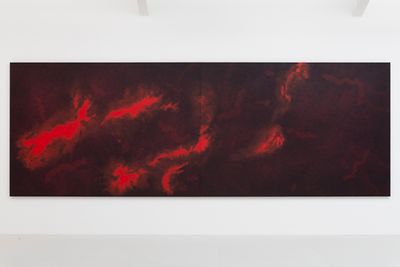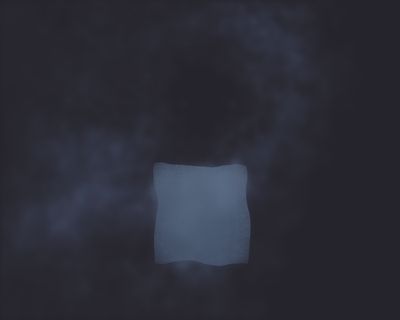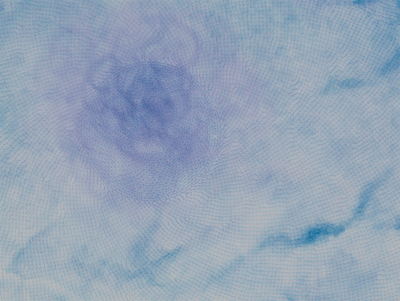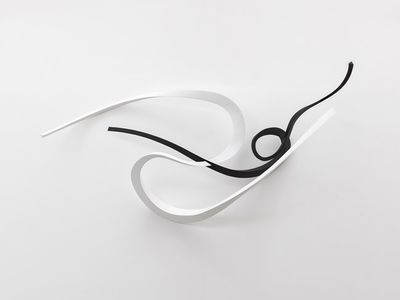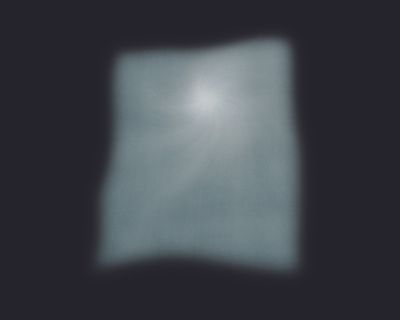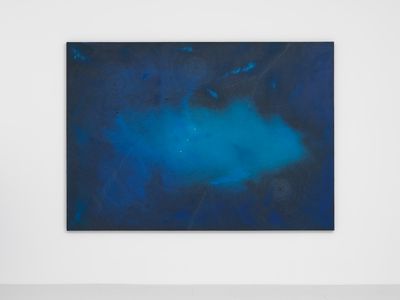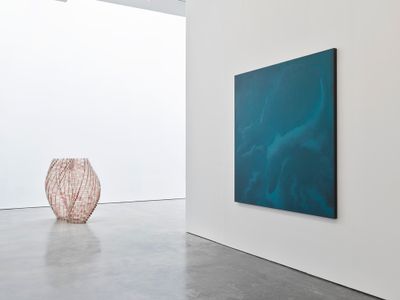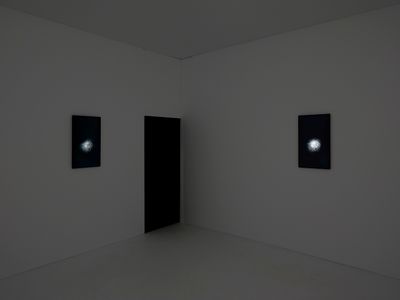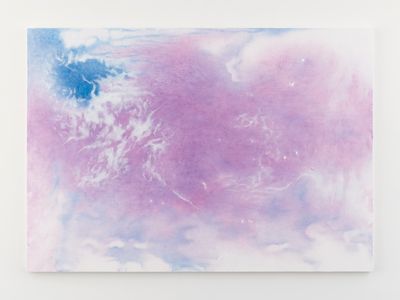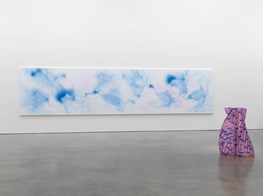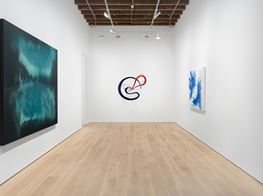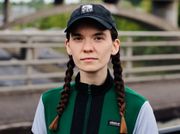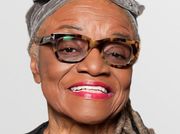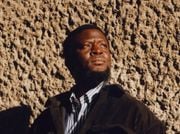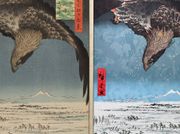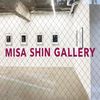Shirazeh Houshiary
Shirazeh Houshiary. Photo: Dave Morgan.
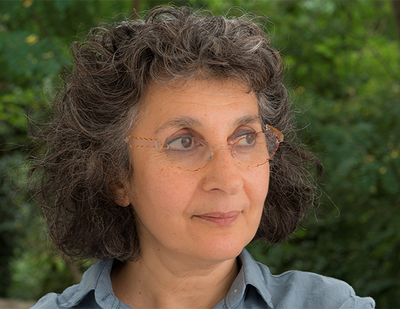
Shirazeh Houshiary. Photo: Dave Morgan.
Shirazeh Houshiary was born in 1955 in Shiraz, an Iranian city known for its rich literary and art history. She came to London in 1974 to study at the Chelsea School of Art, five years before the Iranian Revolution broke out.
It was her sculptural works that first garnered attention in the 1980s, and which also earned her a Turner Prize nomination in 1994, along with Willie Doherty, Peter Doig, and Antony Gormley.
Although she was part of the New British Sculpture movement at that time, Houshiary's body of work encompasses much more than sculpture, extending to painting, video installations and, in more recently, virtual reality.
Houshiary's paintings bristle with contradictions. Genesis (2016), is a molten pool of black and red pigment and pencil on aluminium, which hints at both creation—as the title suggests—and destruction. Veil (1999), a monochromatic acrylic paint and graphite work made up of layer upon layer of pigment both reveals and conceals, giving the impression of both translucence and solidity; it initially appears completely black, but on closer inspection a square form emerges that recalls Malevich's iconic Black Square (1915).
Unsettling, calming, metaphysical and mystical; these are demanding and time-consuming paintings that can take several months to complete. Laying the canvas horizontally on the floor, Houshiary pours washes of pigment on them before applying layers of detailed textures in pencil or paint, some feather-like and others like liquid ripples. Much like water and pigment, breath is a central element in Houshiary's practice. 'I set out to capture my breath', she said in 2000, to 'find the essence of my own existence, transcending name, nationality, cultures.'
From breath and water, Houshiary creates a universe where forms dematerialise and materialise in a veil of colour and repetitive forms. Her work connects shamanism with science, and poetry with physics, drawing a balance between chaos and order. 'The universe is in a process of disintegration', she said in a 2013 interview with Lisson Gallery; 'everything is in a state of erosion, and yet we try to stabilise it. This tension fascinates me and it's at the core of my work'.
Mark Rothko once said that his colour field paintings should be viewed from a distance of 18 inches in order to dominate the viewer's field of vision, thus creating a feeling of contemplation and transcendence. The same could be said of Houshiary's detailed monochromatic paintings, which resemble the cosmos, or microbial matter under a microscope, from a distance. Some works look like soundwaves, nebulae, or the movement of gas as it disperses through the air; they quiver and vibrate, giving the impression of atmospheric phenomena and energy that appear barely contained within the frame. It is only once you step closer that patterns reveal themselves to be miniscule writings: Arabic letters that swirl, undulate, and fade.
Soar (2015) is a haze of blue and violet pigment, across which 'I am' and 'I am not' are repeated in pencil in Arabic, pulsing across the surface of the canvas until they dissolve into a thin veil of clouds. Words play an important role in Houshiary's work. With the simple repetitive gesture of writing a self-affirmation or denial, she creates a space in which different layers of consciousness exist and emerge. The order of our language, philosopher Ludwig Wittgenstein proposed in Zettel, a collection of fragments of his works, arises out of chaos and nothing. So too, Houshiary's work suggests, does our understanding of self.
I spoke to Houshiary in Hong Kong in March 2018, where the artist was being honoured with Asia Society's Asia Arts Game Changer Award alongside Subodh Gupta, Ju Ming, and Park Seo-Bo.
DdWhat kind of art were you initially making when you moved to London?
SHIn Iran, I was more interested in theatre, so the change was dramatic. My real art education was in England. As an art student, I was making a lot of installation art and experimenting with light—it was about how you can intervene in the environment on a large scale. That's how I started, and I moved to sculpture from there; and from sculpture I moved into everything—painting, sculpture, film. I hated these boundaries after some point, because I think these are all artificially created by us. When you're involved with a visual experience, you will experiment with very different tools, and each tool allows you to discover a new vocabulary. Because the tool is new, it gives you a new vision and revitalises the process.
DdYour sculptures are like three-dimensional versions of your paintings. What is the relationship between them?
SHThere is a connection. And I make film, too—animation films on computer, because I'm also interested in the virtual world or the world that doesn't exist, and where the role of the body is in that. In my paintings, the role of the body is very clear, and in my sculpture the body is present. It's really about understanding your position and moving from one experience to another, because all these experiences are available to us as human beings. We are each inside a body—we cannot deny that. We understand the world through our senses; and we are constructed in a particular way that limits our vision of the world outside. It all affects the way we see the world.
The more we try to see the world on a different level—for example, by seeing it through a virtual lens or through our body or our mind—maybe then one can glimpse at reality. Stephen Hawking once wrote that we are like goldfish in a glass bowl. The goldfish's vision of the outside world is distorted because it sees the world through the glass. This is our condition, too—we see the world through our glass, which is our senses, our bodies, even our ethics and moralities. These are all limitations. So how do we see the nature of reality when nature has created us with limitations? In a way, to go from one way of looking to another—say, from two-dimensional to three-dimensional, to no dimension or infinite dimensions—allows me to maybe glimpse at something that is in between all these stages.
The paintings are more of a field, and the sculptures are more of an architectural body. I think fields are very powerful. I was studying the quantum world, and how tiny electron quads are affected by a beam of light, completely distorted and affected by a field. We don't even realise that our body is affected by a powerful field of energy all over the world. You're sitting here before me but you're nothing but energy, and I'm nothing but energy. Even our minds are energy. My paintings have that dimension: creating a field in the vision of the viewer.
DdThe expression of opposing forces encapsulates your work very well. Your work is very much about binaries.
SHYes, because if you look at my paintings you see these two sentences, 'I am' and 'I am not': they are two opposing forces that are a condition of who we are. Our existence and the universe is constantly in dialogue and not divided. We have a space between the two that is in constant collaboration. To be certain and to be uncertain is part of the same story, but we only take the one side. We like the certainty of existence and being sure about the economy, politics, society, our opinions, who we are. We look for certainty, but if you accept uncertainty as part of the same story you see that your whole perception will change.
DdYour paintings require a lot of repetitive gestures and concentration—it seems almost ritualistic.
SHI'm interested in this idea of process and ritual and your experience of it in the work. In a way, I'm trying to understand my own existence in relation to the world around me. I'm trying to dig deep into primordial sources of myself. This is why I think process and ritual is a way of framing for me to understand all of this, because if I didn't understand, it would be reflected on the surface of my work for the viewer to experience. That surface is purely a reflection of my understanding. It cannot just be an intellectual activity. This is a combination of intellectual activity and physical activity—it's both. It's almost like being a scientist; you experiment to understand the nature of what you are trying to understand. What is energy? What is matter? Who am I in all of this? Where is reality? Do I see the nature of truth or do I not see?
DdRitual has been instrumental in building community and civilisation.
SHYes, shamans did that. This is why image-making is part of the evolution of our brain, in a way. The shaman wanted to connect to the world of spirit, to something bigger than himself. He found his own limitations in his own existence, just like that goldfish in the glass bowl. His perception is completely distorted, and he has to connect to something else to have a connection to the outside world. This has always been the role of art, I think: to connect to something universal so that it can connect to other people.
DdIs this why you leave your works quite ambiguous and open?
SHPeople can take whatever they need out of it. They don't have to necessarily understand what I'm trying to get at, but it's a reflection of them. I become a mirror for them to see themselves and find their own way through this conundrum of 'I am' and 'I am not'—of the polarity of our existence.
The linking of the small to the large is what I enjoy more than anything else. From different distances, you're more aware of this field—it's more ethereal on the surface. The moment you come close, you see that it's a tiny structure that is very concrete. So both illusive and concrete, fragile and strong—they exist simultaneously and I'm trying to show that sometimes our understanding of the world is very limited, because we cannot see that opposing forces are continuously in collaboration. They dance together, they are not separated; we are the ones who separate it. And that's why we have a lot of problems and tension in our lives and in society.
DdCan you discuss the importance of water as a medium in your work?
SHIt's a necessity for life. Water flows, just as society flows. Culture flows and shifts and changes. Ideas and thoughts shift and change. I like the movement of water because it flows and cannot be fixed. If you understand the nature of water—that it constantly changes—then you understand that everything changes. Everything is in a state of flux: nature, the world, us with it. But we don't realise that. We create fixed stories about ourselves, our cultures, and there is a tension there. We like to fix everything because it feels more secure. We have a home, stability, a context, and narrative, but these are all artificial. You have to go with this flowing movement. It's hard for us to do that. We struggle with it.
DdIs making the intangible tangible part of what you are trying to do in your art?
SHYes. I would like to say that, for me, what is intangible and invisible is more important than what is visible and tangible. The intangible seems to be something that is more appropriate to grasp.
DdTell me more about your VR work. Does it allow you to circumnavigate around these limitations?
SHYes, but it does also have its own limitations. I've been working with VR since 2003 so I was really working with it from its inception. I did quite a bit of work with breath on the video screen. For Breath (2003), I choreographed the breath of four different vocalists from four different heritages. I tried not to use the technology as a space of emptiness, but as a tool to reach for what is intangible and inaccessible to my senses. There is an awful quality of VR that offers you emptiness.
DdEscapism?
SHYes, I'm not interested in that. It's a cliché. But what is interesting about it is that you can connect to things that you have no access to; that you can't understand because you're limited by your senses. Perhaps with this medium you can connect to something very powerful that you cannot find within your ordinary experience in your physical body. It's a difficult area. I have only created five pieces up to now—and I'm making the last one now. I've been struggling for five years to get it right. It takes me two to three years to do one work and they're very short—five to seven minutes maximum. The virtual can be quite useful to convey certain experiences if it's handled well and not turned into some sort of kitsch spectacle. I just try to use the medium available to me to convey what I feel is sometimes difficult to express through other mediums.
DdI remember seeing Breath (2003) seven years ago in London at Lisson Gallery (No Boundary Condition, 12 October–12 November 2011). That was my first encounter with your work.
SHI made Breath in 2003. It was one of the pieces I showed at the Venice Biennale in 2013. I wanted to see who I was—I looked at a mirror and saw no image of myself. I went very close to the surface of the mirror to see if I could see any reflection. My breath left a residue of mist on the surface of the mirror. I went back to see if I could see anything, and the mist evaporated.
DdThis is interesting in relation to Lacan's concept of the 'mirror stage', when an infant recognises itself in the mirror, which in turn gives rise to the affirmation of the self: the 'I' or 'I am'. Except here you are no longer able to see or recognise the self. It's the breath you see instead, not the reflection.
SHExactly. I discovered that Einstein did a similar thought experiment. Einstein asked: 'If I moved at the speed of light, what would I see when looking into the mirror?' He wouldn't be able to see an image of himself because the light wouldn't have time to go back and hit the mirror and reflect his image. He realised it wasn't fixed. I didn't initially know about this experiment; I only discovered it a year ago, yet I've been talking about it for the last 10 to 15 years.
My experiment was really about identity—whether it is a fixed proposition or whether it is shifting constantly. I realised that it is constantly shifting, and the agony of humans is that they don't like that, and we are constantly trying to fix it. The conflict is huge, and on the individual level it's also a crisis, because identity cannot be fixed. It's impossible, but that is the nature of it. Einstein realised he could not fix it; the speed of light is always stable—light would not be able to come back and hit the mirror, so he would have a void.
Everything else in this universe is related to this idea of fixity and change shifting constantly in relation to each other. But we are only aware of the fixity, not the shifting process. We are surprised about how much we don't understand. We think time exists, but actually in this process time doesn't exist—it is movement that gives the sense of time. Perhaps it is heat that gives us a sense of change; and when it's cold, it doesn't change. Change is time.
DdIt's funny to think about mirrors in an art fair context. Reflective artworks attract scores of people who look at their image on the surface of them, taking selfies.
SHOur biggest problem is that we want to fix that image in the mirror, and there is nothing there. That's why we're attracted to shiny art. It is a desperate affirmation that we exist. It's the uncertainty we don't like.
DdYou once stated, 'I set out to capture my breath, to find the essence of my own existence, transcending name, nationality, cultures.' Your works emphasise the similarities between people—that we all strive for an understanding of the self and of our place in the world.
SHYes. You will begin to see within yourself and the world around you the same thing constantly at work, allowing you to get rid of prejudices and intolerances. There is so much intolerance in the world. This is the problem today, even in a democratic country like the United States, or England with Brexit. Much narrow-mindedness has surfaced. It doesn't matter where you are. We have to dig deep to the source of intolerance.
We're all unique and the same. It's like droplets of water. All the droplets in the ocean are different, and yet they are the same. It's quite amazing. I was surprised when I discovered this, that each droplet has a unique shape. No two droplets are the same.
DdJust like every snowflake is individual.
SHYes. Can you imagine that? Yet, they all have the same structure. Water is an amazing substance. From afar, the paintings look like the cosmos, but actually when you get up close to them the patterns reveal themselves. They have their own identity, like a fingerprint. Our fingerprints are all different. You know where they come from? When we are in the uterus of our mother, in a watery environment; the water leaves a pattern on our skin.
DdThat's incredible.
SHYes, it is! It's not the same pattern, ever. Before we even take our first breath in the world, the memory of the time in our mother's uterus is imprinted upon us. When I understood this I was completely overwhelmed by it. We have so much to learn about who we are. And this is part of our identity. The fingerprint is the only thing that doesn't change. Our faces and bodies change, but not our fingerprints.
DdYou engage so much with physics in your work. Did you ever want to be a scientist?
SHI did actually. But I loved art too much. —[O]

